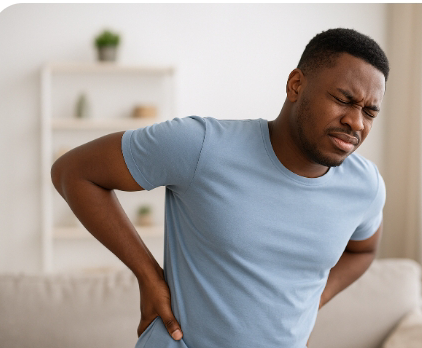
Tropical herbs build energy
Discover how tropical herbs build energy naturally through CombiHs herbal synergy. From roots to spices, explore how nature fuels lasting vitality across all ages

Ayurvedic Treatment for Lumbar Pain:
Title:
low back pain and radiation pain Naturally
Visit our online shop for effective combiHs products
Introduction
Lumbar pain, commonly known in orthodox medicine as low back pain, is one of the most prevalent musculoskeletal complaints across the world.
In some cases, the pain extends into the legs, a condition called sciatica.
Ayurvedic Treatment for Lumbar Pain is refered in as Katishoola (lumbar pain) or Gridhrasi (sciatica-like pain).
Ayurveda views these conditions as manifestations of aggravated Vata dosha, resulting in stiffness, dryness, and nerve irritation.
Causes:
From a medical perspective, low back pain arises due to slipped discs, arthritis, spinal stenosis, muscular strain, disc herniation or degeneration muscular or ligament strain osteoarthritis or spondylosis, osteoporosis or weak spinal bones, poor posture or trauma
In Ayurveda, the root cause is Vata vitiation, aggravated by factors such as irregular routines, aging, excessive physical strain, or a diet lacking warmth and nourishment.
Symptoms of low back pain
The condition is often marked by:
Persistent dull or sharp low back pain
Pain radiating into the buttocks and legs (sciatica)
Tingling, numbness, or weakness in the legs
Muscle stiffness and reduced mobility
Pain aggravated by bending or prolonged sitting.
Lubar pain is one of the symptoms
These symptoms align with Vata imbalance, where natural body movement and flexibility are disturbed.
Ayurvedic Treatment for low back pain
Ayurvedic treatment emphasizes restoring balance to Vata dosha, strengthening the spine, and relieving inflammation.
This is achieved through a combination of herbal medicines, therapies, diet, and lifestyle corrections.
1. Herbal Remedies
The following herbs are highly recommended in Ayurveda for Katishoola and Gridhrasi:
Dashmoola – classical ten-root combination that pacifies Vata.
Shallaki (Boswellia serrata) – relieves stiffness and swelling.
Yograj Guggulu – detoxifies, strengthens joints and muscles.
Ashwagandha (Withania somnifera) – a rejuvenative nerve tonic.
Rasna (Pluchea lanceolata) – reduces pain and stiffness.
Nirgundi (Vitex negundo) – effective for nerve pain and inflammation.
2. Panchakarma Therapies
Ayurvedic therapies used in chronic lumbar pain include:
Kati Basti – localized oil pooling on the lumbar spine.
Abhyanga – full-body medicated oil massage.
Swedana – herbal steam therapy for stiffness relief.
Basti (Medicated Enema) – regarded as the most effective therapy for Vata disorders.
3. 90-Day Medication Schedule
Dashmoola – 30 g
Yograj Guggulu – 20 g
Shallaki – 20 g
Ashwagandha – 20 g
Rasna – 5 g
Nirgundi – 5 g
Dosage & Usage (for 90 days)
Powder form: 5 g (1 teaspoon) with warm water or milk, twice daily after meals.
Tablet form (if prepared): Equivalent to ~500 mg–1 g per dose, twice daily.
4. Lifestyle and Diet
Favor warm, freshly cooked meals that pacify Vata.
Avoid cold, stale, and excessively dry foods.
Gentle yoga postures like Bhujangasana (cobra pose) and Makarasana (crocodile pose).
Adequate rest with correct posture while sitting and sleeping.
Conclusion
Lumbar pain, identified as low back pain in modern medicine and as Katishoola or Gridhrasi in Ayurveda, can be managed naturally with herbs, therapies, and lifestyle changes.
With consistent use of Ayurvedic remedies and therapies over a 90-day period, significant relief and long-term wellness can be achieved.

Discover how tropical herbs build energy naturally through CombiHs herbal synergy. From roots to spices, explore how nature fuels lasting vitality across all ages

Explore traditional herbal wisdom and daily plant practices that promote balance, health, and lasting vitality for true herbal longevity.
We deliver core herbal procedure cures for our users for better and more efficient health value.
Lets discus your health
Connect with us